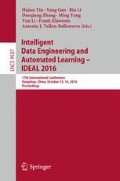Abstract
Echo State Networks (ESNs) have attracted wide attention for their superior performance in time series prediction. However, it is difficult to design an ESN to match with the given application. In this paper, an approach is proposed to design growing echo state networks. The basic idea of the proposed method is to design a growing reservoir with multiple sub-reservoirs by adding hidden units to the network group by group. First, several subservoirs are synchronously constructed by using the singular value decomposition. Then, every subservoir is evaluated and the best one is selected to be added to the network. Finally, two time series are used to validate the proposed approach.
Access this chapter
Tax calculation will be finalised at checkout
Purchases are for personal use only
Notes
- 1.
According to reference [20], the column vectors of H can be made full-rank with probability one.
- 2.
Size, sparsity and spectral radius of reservoirs are optimized by the conventional grid search method.
References
Schafer, A.M., Zimmermann, H.G.: Recurrent neural networks are universal approximators. Int. J. Neural Syst. 17(04), 253–263 (2007)
Jaeger, H.: Tutorial on training recurrent neural networks, covering BPTT, RTRL, EKF and echo state network approach. Tech. report 159, German National Research Center for Information Technology, St. Augustin, Germany (2002)
Doya, K.: Recurrent networks: learning algorithms. In: Arbib, M.A. (ed.) The Handbook of Brain Theory and Neural Networks, pp. 955–960. MIT Press, Cambridge (2003)
Sutskever, I.: Training recurrent neural networks. Dissertation, University of Toronto (2013)
Li, D.C., Han, M., Wang, J.: Chaotic time series prediction based on a novel robust echo state network. IEEE Trans. Neural Netw. Learn. Syst. 23(5), 787–799 (2012)
Zhang, B., Miller, D.J., Wang, Y.: Nonlinear system modeling with random matrices: echo state networks revisited. IEEE Trans. Neural Netw. Learn. Syst. 23(1), 175–182 (2012)
Jaeger, H., Haas, H.: Harnessing nonlinearity: predicting chaotic systems and saving energy in wireless communication. Science 304(5667), 78–80 (2004)
Jaeger, H.: The echo state approach to analyzing and training recurrent neural networks. Technical report 148, German National Research Center for Information Technology, St. Augustin, Germany (2001)
Rao, J.S.: Optimization. In: Rao, J.S. (ed.) History of Rotating Machinery Dynamics. HMMS, vol. 20, pp. 341–351. Springer, Heidelberg (2011)
Pan, Y.P., Wang, J.: Model predictive control of unknown nonlinear dynamical systems based on recurrent neural networks. IEEE Trans. Ind. Electron. 59(8), 3089–3101 (2012)
Skowronski, M.D., Harris, J.G.: Automatic speech recognition using a predictive echo state network classifier. Neural Netw. 20(3), 414–423 (2007)
Xia, Y., Jelfs, B., Van Hulle, M.M., et al.: An augmented echo state network for nonlinear adaptive filtering of complex noncircular signals. IEEE Trans. Neural Netw. 22(1), 74–83 (2011)
Shi, Z.W., Han, M.: Support vector echo-state machine for chaotic time-series prediction. IEEE Trans. Neural Netw. 18(2), 359–372 (2007)
Lukosevicius, M., Jaeger, H., Schrauwen, B.: Reservoir computing trends. KI-Knstliche Intelligenz 26(4), 365–371 (2012)
LukosEvicIus, M., Jaeger, H.: Reservoir computing approaches to recurrent neural network training. Comput. Sci. Rev. 3(3), 127–149 (2009)
Strauss, T., Wustlich, W., Labahn, R.: Design strategies for weight matrices of echo state networks. Neural Comput. 24(12), 3246–3276 (2012)
Rodan, A., Tino, P.: Minimum complexity echo state network. IEEE Trans. Neural Netw. 22(1), 131–144 (2011)
Deng, Z., Zhang, Y.: Collective behavior of a small-world recurrent neural system with scale-free distribution. IEEE Trans. Neural Netw. 18(5), 1364–1375 (2007)
Xue, Y., Yang, L., Haykin, S.: Decoupled echo state networks with lateral inhibition. Neural Netw. 20(3), 365–376 (2007)
Qiao, J., Li, F., Han, H., et al.: Growing echo-state network with multiple subreservoirs. IEEE Trans. Neural Netw. Learn. Syst. PP(99), 1–14 (2016)
Author information
Authors and Affiliations
Corresponding author
Editor information
Editors and Affiliations
Rights and permissions
Copyright information
© 2016 Springer International Publishing AG
About this paper
Cite this paper
Fan-jun, L., Ying, L. (2016). An Approach to Design Growing Echo State Networks. In: Yin, H., et al. Intelligent Data Engineering and Automated Learning – IDEAL 2016. IDEAL 2016. Lecture Notes in Computer Science(), vol 9937. Springer, Cham. https://doi.org/10.1007/978-3-319-46257-8_24
Download citation
DOI: https://doi.org/10.1007/978-3-319-46257-8_24
Published:
Publisher Name: Springer, Cham
Print ISBN: 978-3-319-46256-1
Online ISBN: 978-3-319-46257-8
eBook Packages: Computer ScienceComputer Science (R0)

